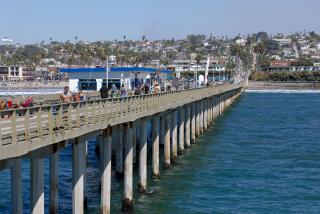City Convention Center Cost Hikes Pose Double Dilemma for Officials
- Share via
Attempts to eliminate a projected $22-million cost increase for San Diego’s waterfront convention center could result in lengthy delays, severe cutbacks in architectural quality and a building considerably less attractive to potential conventioneers, a special mayoral task force was told Wednesday.
The glum prediction that the San Diego Unified Port District faces two equally unattractive alternatives--swallowing most of the cost overruns, or delaying and aesthetically damaging a project already six months behind schedule--came as the task force began to review alternatives designed to reduce the controversial project’s costs.
Also Wednesday, mayoral candidate Maureen O’Connor, criticizing what she described as “the go-go, build-build, spend-spend philosophy” of those who favor quickly proceeding with the project, sent a letter to the task force suggesting that the project either be rebid or redesigned in an effort to reduce costs.
“I’m only slightly more confused than I was when the day began,” Port Commissioner William Rick said, only half-jokingly, after attending two meetings and receiving three written reports dealing with the convention center situation. “There’s an awful lot of numbers and ideas to digest. That’s going to take a while.”
As officials continued their search for answers to why the bids to build the 1.4-million-square-foot structure came in more than $20 million over the Port District’s $101.5-million budget, and how to cope with that problem, Wednesday’s developments included:
- A report from a Port District consultant that explains the cost overruns by noting that there was “a degree of inaccuracy built into” original price estimates, which were made when the project was about 60% complete. In addition, port officials explained that increases in the amount of steel and concrete needed to build the convention center, initially identified as the major factors in the projected cost jump, apparently were just two of several key elements that resulted in the higher cost.
- Presentation of a long list of cost-cutting alternatives ranging from relatively minor design changes to drastic architectural alterations that some task force members argued would result in a structure that falls far short of the “world-class” quality sought. Deputy City Manager John Fowler also stressed that, “this side of a rebid,” the most that could be saved through those changes is about $15 million.
- A recommendation from the project’s architect, Ward Deems, that characterizes the higher-than-expected bids as simply the realistic cost of building the convention center. In a 31-page report, Deems recommended that the port commissioners immediately award the construction contract to the “lowest responsible bidder,” and later negotiate with the contractor on reducing costs by about $6 million.
The task force that met at City Hall Wednesday, which consists of local business and civic leaders including architects and construction experts, was formed by acting Mayor Ed Struiksma to help explain “why we are where we are.”
That question arose after the lowest base bid on the project, submitted by Continental Heller Corp. of Sacramento, was $123.9 million--about $22.4 million more than the projected budget. The other five bids range from $124.9 million to $133.7 million.
In addition, Rick has emphasized that excavation, utilities, furnishings and other costs could push the final cost of the center to nearly $160 million--$65 million more than the $95-million price tag often cited in the November, 1983, campaign in which San Diegans approved the project in an advisory vote.
Expanding on explanations that he has offered earlier, Rick pointed out Wednesday that two “highly qualified” firms--one hired by Deems, the other by the port--last fall produced cost estimates within about $1 million of each other.
“The apparent concurrence of the numbers . . . gave us the comfort to proceed,” Rick said.
After bids were solicited, however, Deems’ engineers continued to review the project with city building inspection consultants, a process that resulted in gradual design changes--notably, in the amount of steel and concrete needed to meet city standards. The full financial impact of those changes, however, was not realized until the bids were received about two weeks ago, Rick explained.
In its report Wednesday, Howard Needles Tammen & Bergendoff, the Los Angeles-based consulting firm hired by the port to review the project, noted that its final cost estimates last October were “based on a project that at the time . . . was approximately 60% complete.”
“Therefore, there is a degree of inaccuracy built into the estimate,” the four-page HNTB report said. “Certainly, the drawings had not been reviewed by the (city) plan check people nor had the final decisions by the design team been made.” Deems’ report offers a similar explanation.
The HNTB report also indicates that the increased steel and concrete requirements, while still major factors in the project’s overall cost increase, were less significant than port officials initially thought. Last week, Rick and other port officials said that about $18 million of the increase could be attributed to the fact that about 30% more concrete and double the amount of steel originally estimated might be needed.
However, Rick said Wednesday that the discrepancy over steel and concrete apparently produced, according to the HNTB report, only about an $8-million price increase.
The report states that the remainder of the $20-million-plus cost increase stems from changes in the building’s mechanical equipment ($4 million), reductions in construction timetables ($4 million), drainage expenses ($2 million), increases in liability insurance and other overhead ($2 million), and various other design changes ($3 million).
Separate reports prepared by city officials and Deems, both of which were presented to the task force Wednesday, identify various alternatives on how the port might proceed in the face of the projected cost increases.
One of the cost-cutting possibilities included in the city’s report focuses on elimination of one of the major architectural features of the proposed convention center--an open-tented roof that could provide additional meeting space with a dramatic bayfront view. Elimination of the tented roof, Fowler said, could reduce costs by about $8 million.
However, in a letter to port leaders, architect Arthur Erickson, Deems’ partner on the project, termed elimination of the tented roof “a mistaken economy” that would reduce the center’s “attraction to conventioneers and San Diegans alike.”
A similar fear was expressed by task force member Jim Granby, president of the convention center’s board of directors, who warned his colleagues that elimination of the open-tented roof could result in a “considerably less than . . . first-class facility.”
“If you lose the 100,000 feet under the tents, your square footage is equivalent to the Fresno convention center,” not that of a “world-class” center, Granby said.
Deems’ report, meanwhile, identifies numerous possible cost reductions. Those alternatives range from minor options such as revising an exterior elevator’s design from glass to concrete, replacing inactive louvers with stucco, and changes in the center’s paging system--changes that could result in savings of about $200,000 each--to more dramatic design changes, such as reducing the structure’s size or eliminating underground parking facilities. The major changes, however, could delay the project by six months to two years, Rick said.
In encouraging the port to quickly proceed with the project rather seeking to reduce costs via a major redesign or solicitation of new bids, Deems’ report argued that the center’s projected price is a “fair and reasonable cost” that is less than the average cost of convention centers being built elsewhere.
According to one recent survey, the average cost for convention centers “of a size and quality” comparable to San Diego’s is $128 per square foot, excluding parking facilities. The low bid received by the port, Deems said, equals $121 per square foot.
One person not troubled by the prospect of a delay in the center’s construction is O’Connor, who said Wednesday that a delay “may be necessary in order to really go through the thorough reevaluation needed.”
“Rebidding would cause a delay,” O’Connor said. “But that’s a reasonable tradeoff when you’re talking about a building that’s going to be on the bay into the next century and when you’re trying to save $65 million in public money.”
More to Read
Sign up for Essential California
The most important California stories and recommendations in your inbox every morning.
You may occasionally receive promotional content from the Los Angeles Times.













